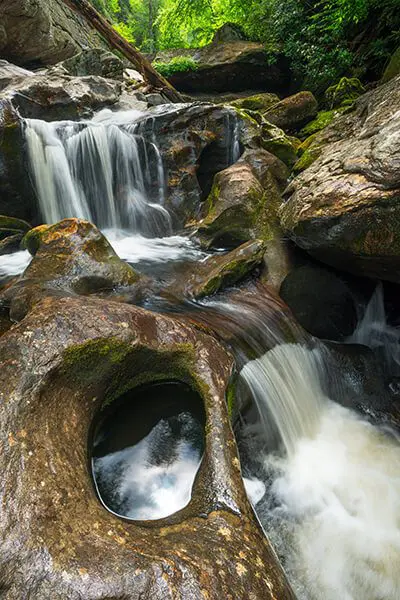A Geologist Explains Waterfall Formation
November 30, 2023

Waterfalls create a visceral experience. The eyes see water cascade down a rock wall then splash into the plunge pool. They see a rainbow of colors as light refracts through the spray. The ears hear a roar of water rushing over the cliff edge, then a crash into the water and rocks below. The skin feels the cool damp mist of a waterfall-induced breeze.
For the experiential brain, this is plenty. But sometimes the rational brain wants answers. The rational brain grasps the concepts of gravity, causing water to move rapidly down steep slopes or over cliffs. And the rational brain realizes that for water to move over this cliff or steep slope, a water source must exist.
Attempting to explain natural phenomena in the Appalachian Mountains, including waterfalls, usually requires a natural history backstory.
The Appalachian Mountains have been described as very old mountains with a facelift. The rocks that make up these mountains come from two main sources: ocean sediments that, under pressure, turn into solid rock and then thrust upon each other via tectonic plate convergence; and volcanic/ igneous activity.
During a 200-million-year stretch between (approximately) 450 and 250 million years ago, the Appalachian Mountains took shape. Tectonic plates crashed together in three separate mountain building events, culminating in the formation of supercontinent Pangaea. These events broke and bent sedimentary and igneous rocks into and on top of each other, as evidenced by countless faults and folds throughout the Appalachians.
A similar mountain building/ supercontinent forming event happened even earlier – over a billion years ago in roughly the same place. The Grenville mountains and Rodinia were formed then. In geologic terms, the Appalachian Mountains are a gigantic puzzle.
While either (or both) of these events created slopes steep enough for water to cascade from, earth scientists tell us that these ancient mountains most likely eroded flat in 20-30 million years after they formed around 250 million years ago. As such, the Appalachians shouldn’t be here.
Researchers indicate that the modern Appalachian Mountains, as we know them, exist due to a (geologically) recent tectonic uplift, believed to have started 5 to 15 million years ago. This uplift formed many of the cliffs, coves, and valleys present today – thus the “facelift”.
So… established within the modern Appalachian Mountains are slopes and cliffs available for water to cascade over. The region provides a catchment for rainwater. Groundwater infiltration seeps down the slope toward established streams. Episodic microbursts produce boulder-moving floods in these streams. All waterfall making components are present.
The leading hypothetical model proposes that waterfalls tend to form where erosion-resistant rock overlies less resistant rock. The upper, resistant layer exposed to the flow maintains its integrity, but the underlying, less resistant rock exposed at the plunge pool gets undercut. This undercutting of the less-resistant underlying rock causes the overhanging rock to shear off. Through this process, waterfalls maintain the steep cliff-like drop and perpetuate slot canyon formation.
Another recent study by Joel Scheingross, a waterfall researcher at the University of Reno, Nevada, suggests that waterfalls can occur spontaneously under the right circumstances.
Scheingross set up a flume experiment with water and sediment flowing across an artificial bedrock. After four hours of run-time, Scheingross’s flume experiment eroded wave-like ripple structures into the artificial bedrock.
These ripple structures created slopes and dips of sufficient shape and scale to produce waterfalls. His experiment of four hours simulated hundreds to thousands of years of flow processes in the natural environment.
Whether seeking a visceral sensory experience or digging deep into the science for rational explanations, waterfalls are magnets. We seek them out. We feel their awe. And mostly, that’s enough.
Anton DuMars
Anton DuMars is an Instructor at the NC Arboretum and the author of The Salt Marsh Diaries. He lives with his wife and dog, splitting his time between the South Carolina Lowcountry, the Chesapeake Bay, and the Blue Ridge Mountains.

